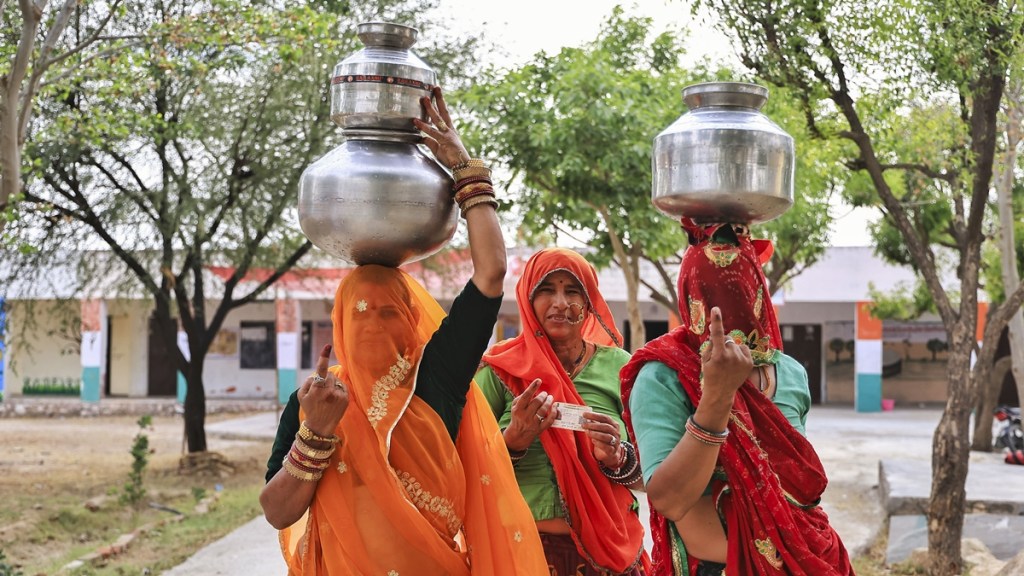More than 63 per cent of eligible voters participated in the second phase of India’s Lok Sabha elections, covering 88 seats across 13 states. The National Democratic Alliance (NDA), led by Prime Minister Modi, is aiming for a third consecutive term with a stronger mandate, as Opposition coalition, INDIA, seeks to regain ground following setbacks in previous elections.
Polling for the second stage of the seven-phase elections started at 7 AM and ended at 6 PM. Despite intense heat conditions in many regions, the Election Commission reported largely peaceful proceedings. The preliminary voter turnout figure at 8 PM stood at 63.50 per cent, with the expectation of a slight increase as final reports are compiled. The Election Commission emphasized that individuals present at polling stations by the end of voting hours were permitted to vote.
According to Election Commission data, Tripura recorded the highest voter turnout at 79.66 per cent, followed by Manipur at 78.78 per cent. Turnout percentages were lower in Uttar Pradesh at 54.85 per cent and Bihar at 57.81 per cent.
Constituencies that went to polls in this phase included all 20 seats in Kerala, 14 of Karnataka’s 28 seats, 13 seats in Rajasthan, and 8 seats each in Maharashtra and Uttar Pradesh.
Notable candidates included Congress leader Shashi Tharoor, Union Minister Rajeev Chandrasekhar, actor-turned-politician Arun Govil, and BJP incumbents Hema Malini, Om Birla, and Gajendra Singh Shekhawat.
In Kerala, voter turnout reached 70.21 per cent. Despite stringent security measures, the electoral process proceeded relatively smoothly, with few incidents reported. However, instances of fraudulent voting and technical malfunctions with electronic voting machines (EVMs) occurred in select booths, leading to delays in polling.
In tragic incidents, one person each from Palakkad, Alappuzha, and Malappuram districts passed away after casting their votes. A polling agent collapsed and died at a booth in Kozhikode.
Meanwhile, a jawan of the Madhya Pradesh Special Armed Force deployed on poll duty allegedly died by suicide by shooting himself with his service rifle at a government school where he was stationed in Gariaband district under the Mahasamund seat in Chhattisgarh.
In ethnic-strife hit Manipur, voter turnout reached a notably high 78.78 per cent despite the heavy presence of security personnel. Reports of intimidation by suspected militants, clashes between Congress workers and supporters of the National People’s Party (NPF), and incidents of EVM damage at a polling station in the Tangkhul Naga-dominated hill district.
At the KK Leishi Phanit polling station in Ukhrul, enraged voters destroyed an EVM and other equipment following alleged disruptions by armed individuals.
Meanwhile, in Karnataka, the overall voter turnout stood at 68.47 per cent.
The Election Commission of India said that a case was registered against BJP MP and Bangalore South Candidate Tejasvi Surya for purportedly sharing a video on a social media platform and seeking votes based on religious grounds.
Another BJP leader, CT Ravi, faced allegations of inciting hatred and discord among citizens through a social media post.
The voter turnout in Jammu and Kashmir recorded 72.72 per cent. The Lok Sabha polls are the first major electoral battle in Jammu and Kashmir after the abrogation of Article 370 and the bifurcation of the erstwhile state into Union territories — Jammu and Kashmir and Ladakh — on August 5, 2019.
The Election Commission registered nearly 300 complaints in West Bengal, mostly related to EVM malfunctioning.
With the completion of polling in Kerala, Rajasthan, and Tripura, attention now turns to the third phase of elections scheduled for May 7 across 12 states and Union territories. Counting of votes is on June 4.

